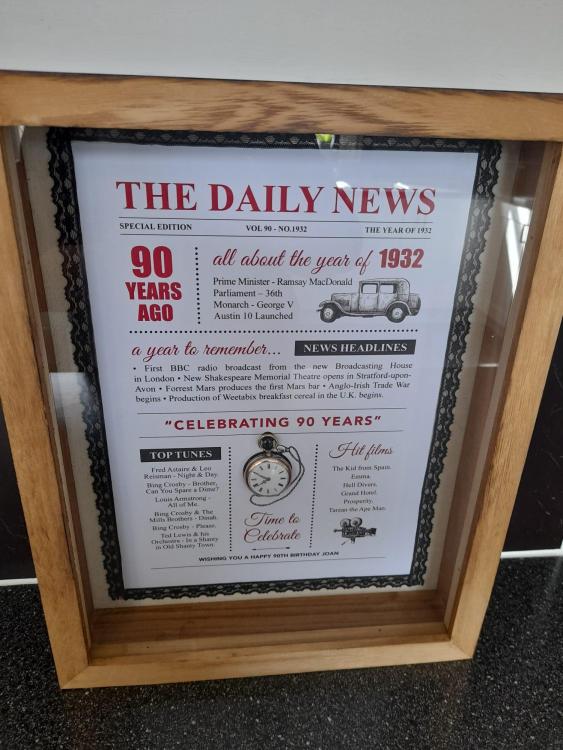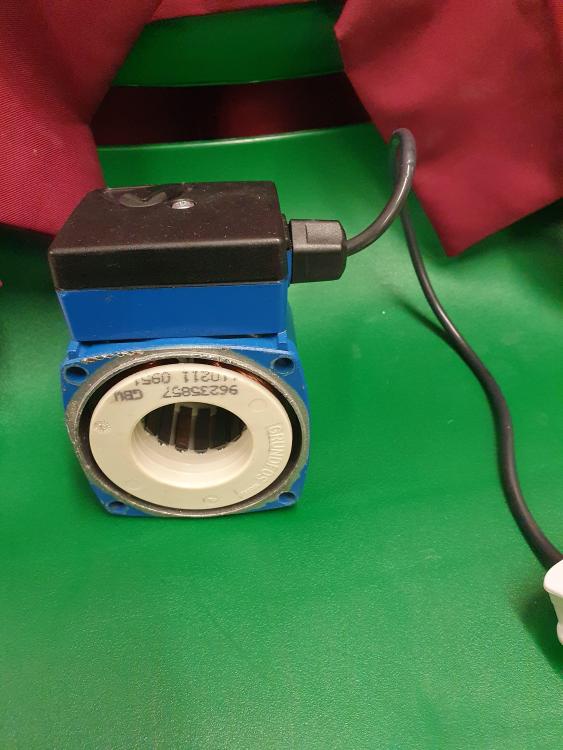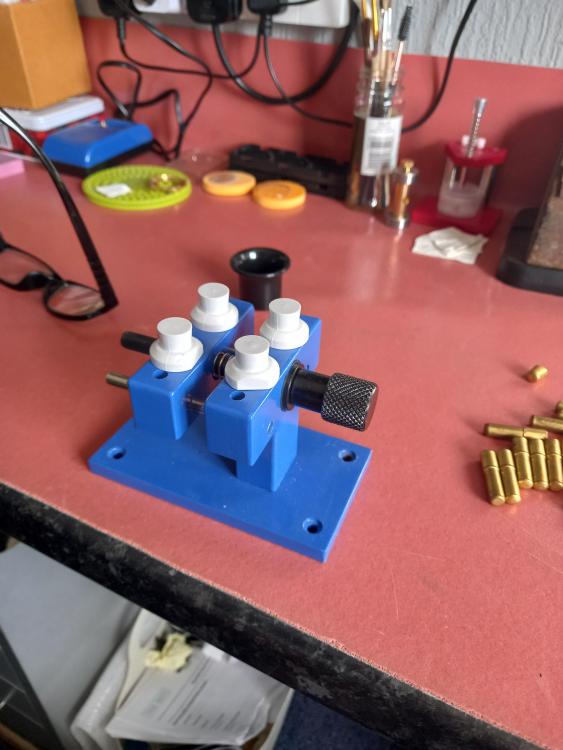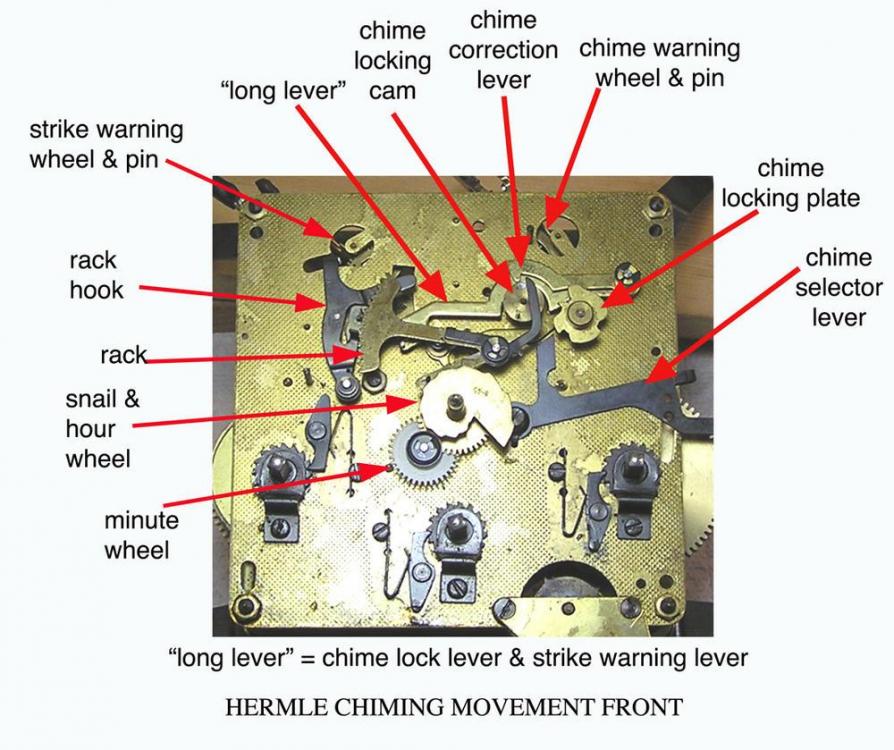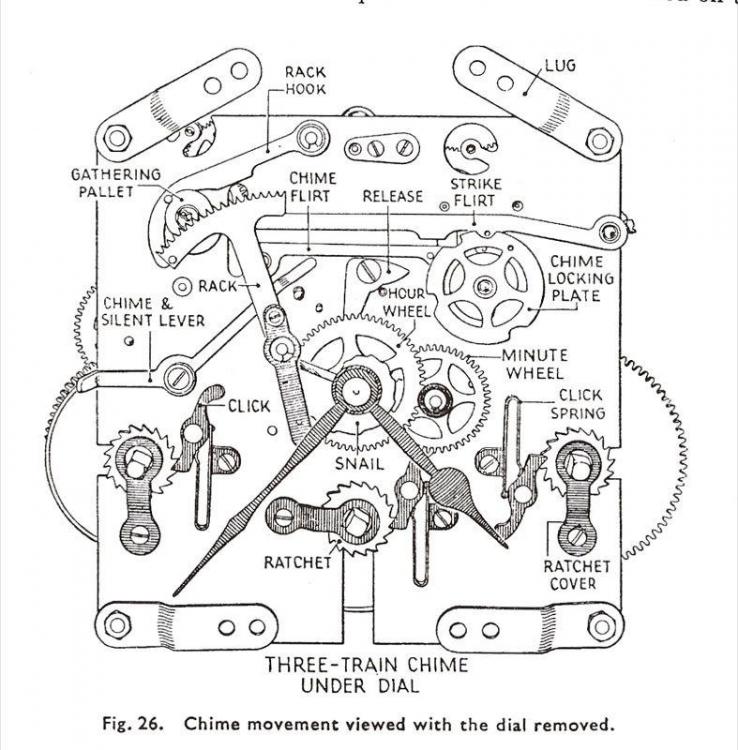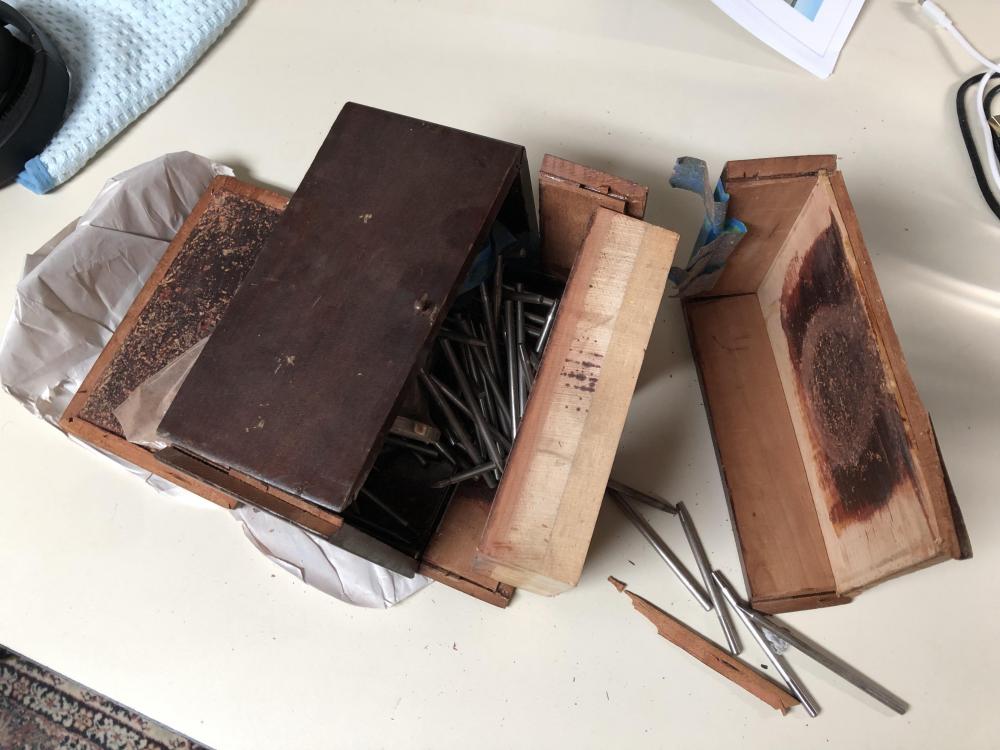Leaderboard
Popular Content
Showing content with the highest reputation on 05/18/22 in all areas
-
Thank you Kalanag, and to all. Done it. Been trying for days. Ping, ping, ping. Search for the spring. Tried it again today. A small piece of Rodico on the spring stuck to the tweezers when I removed the spring from the Rodico. Used that as the holder, placed it against the gap. Closed my eyes and took a breath. Now I'll push it in. What? Don't need to, as it is already in. Gently push each side of the spring into place. Done!!! Cleaned the base again. Tomorrow I will try to put the gems back in. Woohoo! Ross3 points
-
With the slo-mo video function of any recent cellphone it is easy to find (see) the amplitude. Just saying… My Citizen 6900 with 28800bph and about 200° amplitude: https://youtu.be/bjHTD_2bd4k2 points
-
2 points
-
I bought the balance staff removal tool first then realized I needed the staking set. lol. Buying more tools never seems to be a problem. Matt2 points
-
The movement you posted is not a chime, it's a strike. It should strike on the hour and it strikes 1 on the half hour. When it strikes on the hour, put the hour hand and minute hand on so the minute hand points to 12. When it strikes the half hour the minute hand will be pointing at six on the dial. Don't bother with the chime as its not the movement you have and it might confuse you.2 points
-
Hi @Tiny Remember to always look around the family your movement comes from where you don't come up trumps if you just use your specific movement reference. Your 791 is a manual wind no seconds but a 781 is in the same family with a second hand; the 794 an automatic with date. Differences of course but the same basics. Then Cousins is good for docs: https://www.cousinsuk.com/document/search?SearchString=Tissot. Note 781, 794 etc. Or google tissot 794 pdf You get the gist. Hopefully this will get to what you need.1 point
-
Found this parts list. However the movement does not seem over complicated..Just strip the movement down taking plenty of pics and service. https://www.watch-spares.com/tag/tissot-mechanical-movements/page/6/1 point
-
It probably is for the hour wheel greg. There are smoothing and cutting broaches. Be very careful when opening it up, just a little at a time as it is very easy to overshoot and with a little oil to help the cut. I always go with a fine broach with very little gain on the stem, so that the cut isn't at all aggresive, slow and steady. Its easy to take more out, nigh impossible to put it back. Then a smoothing broach to dress the cut.1 point
-
The reason I wanted the serial number was for the website below. The reason I wanted the serial number was for the website below. You can look up information about your watch. You can find out that yours was one of 100 in that batch which is a really small batch use of the batches are bigger. Then there's the total quantity of watches made and you can even find out by clicking the model number how many of that probably made etc. https://pocketwatchdatabase.com/search/result/waltham/2125977 Then it's not mentioned above but both Waltham and Elgin exported heck of a lot of watches out of the country. They had a sales agent in United Kingdom in several other locations. Which means you can look at eBay UK for your watch you'll just have to spend some time looking. That's a unfortunate problem of vintage finding parts can be a challenge in finding a month eBay can take some time. But at least there is eBay and the parts can be found or the movements can be found eventually. Then if you really desperate there is another option. You should bill a find some way doing an equivalent service in United Kingdom there won't be a lot of people like this but they do exist that is somebody can replace the damaged component make a new one. https://henningwatches.com/index-2.html1 point
-
That answer may not the correct? Yes sometimes to view purchase movements off of eBay somebody might've done mixing and matching perhaps. One of the problems you'll find with specially on American pocket watches is cannon pinions are basically hand you. This means each one has been adjusted to the center wheel but it goes on if it is too tight you'll have to solve that problem as getting an identical looking one may not fit at all either of the way too tight or it could be too loose. So if yours is too tight you have to fix the problem. You also need to fix the problem of the hour and minute wheel they need to go on without tight fitting they have to revolve effortlessly without being a loose. This is the unfortunate consequence of American watch repair is you have to repair versus trying to swap your way out of a parts problem where you introduce new problems. Which means of somebody has played with this watch before you you made now be dealing with the consequences of that.1 point
-
1 point
-
Hi the sequence of events is, the center cam (two lobes) one for strike (longer) and the shorter one for the 1/2 hr. as the cam turns the longer lobe lifts the long lever and puts the clock into warning (warning wheel rotates and locks) then as the cam rotates it drops the long lever and initiates the strike. The same sequence operates on the 1/2hr but the long lever is not lifted so high. warning then lock then release. As Old Hippy said move the hands to initiate the strike (hour) take of the hands and re fit for the correct strike count. Now move the hands to the 1/2 hr position and it should strike the 1/2 hr then back to the hour and it should strike the hour. as said this is a two train clock one going and one strike.1 point
-
1 point
-
I Have a sticky wand uses for picking up small gemstones available in the HOBBIES shops in various sizes, very handy for small screws as well.1 point
-
1 point
-
I would put a temporary strap on it and then put the watch in a good solid watch vice like this. Not expesive. Just be careful to look out for the spring bars breaking out of the lugs or the bar holes becoming damaged if it is so tight. Or a hard timber insert to fit tight between the lugs. If the lugs weren't so thick and part of the cushion case i wouldnt have tried this.1 point
-
1 point
-
Thanks all for the welcome. I see the 25th anniversary Charlie watches are fairly common - not something I would have gone out of my way to get but did think it was cool and would wear if I could get it running. I did take apart - movement is discontinued to go the replacement route. At first I had some minor movement of the second hand, indicating dry/dirty inside. I removed many of the gears, front and back, marvelling at the size of them and the screws. All seemed clean. On my second look inside I did use low pressure air (<20psi) and after that I had no more movement. I was wondering if I damaged the coil. I will refer to the two attached pdfs, thank you. I do know I need some smaller screwdrivers for sure - the 'regular' small ones I had already only went down to 1.0mm and were too thick. I will have to research a set or individuals to start with that do not break the bank. Have a good day all.1 point
-
I oil it if it seems dry; the spindle a couple of times per year maybe, screw every couple perhaps. I use fine machine spindle oil, but any is really fine, 3 in 1, sewing machine, clock.1 point
-
I would really suggest if you watch the video would be to practice with some bigger hairsprings. Henry makes it look really really easy because he had a heck of a lot of experience doing this.1 point
-
One can anly concur with the advise given, startwith a strike only before moving on to the westminster as there are many complications, the auro correction , the timing of th warnings, and the cams and levers. You need to do a bit of research and reading before attempting the westminster. Hi There is a site by Barrie Smith (no relation) on siths clocks you might find usefull reading. Attached a couple of picks explainging the fromt plate levers. They differ from clock to clock but do the same job. De Carles book on clock repairing and Mike Watters book worth a read also Laurie Pennman and Brian Loomes.1 point
-
This is the joys of being a horologist. I am working on a non working smiths 8 day clock. The screws that hold the plate together were loose. So far a baldly torn mainspring, gathering pin missing + gathering plate loose, click spring broken + many bushes including barrel bushing to be replaced. Explained to customer repairs will cost far more than the clock is worth but still given the go ahead..1 point
-
The problem with watch repair is cleaning doesn't fix everything. Throwing the current watch in the trashing getting a new movement isn't really a way of learning watch repair we really should fix the one you have . There's something is puzzling me? You can get all is really wonderful pictures of the balance wheel when it's out of the watch but the balance wheel in the watch she took the picture at arms length why? We need to see the balance wheel in the watch and we need to see it with the same kind of detail almost that you had of the balance wheel out of the watch they hairspring is a little out of center but that's not a problem we need a decent picture sideways we need to see where the hairspring is is it flat because of it's not flat and it's touching the balance arms of the balance bridge that is definitely an issue but we can't see that for many your pictures I is that?1 point
-
Just an update at the close of this little project of mine. Here's a picture of the final article, warts-and-all. You can see the damage to the scale, and the flaking paint I mentioned earlier, neither of which affect the function of the tool, which I'm delighted with. Something else I learned which may or may not be useful for others to know. The knurled ring on top of the micrometer screw is a separate part and a simple interference fit above the scale. Thanks again to everyone who offered advice and assistance.1 point
-
I struggle with this issue a lot as well. Even simple household items rust very easily for me if they aren't good quality steel. Colored silica gel are great. But they expire really quickly if the toolbox or storage container isn't airtight. In my case in just a matter of days, color changes from orange to dark green. If you buy in large batches and didn't store them properly, be prepared for a shock when the whole batch expires. Sometimes, they even arrive in the mail already expired, and if you got the non-colored version then there is no way for you to find out. Its a borderline scam. Also, I don't recommend the oven/microwave method to recharge these, as you really don't know the quality control of these little balls. For all we know they could very well be tainted with uranium or cyanide. Or whatever. So to really solve this problem, I use two things together: 1) An airtight drybox: I find the best are the ones camera enthusiasts use, they even come with hygrometers (shows humidity levels). I like the cheap Nakabayashi ones: https://www.nakabayashi-global.com/products-all/capaty-dry-box 2) "Branded" rechargeable silica gels: Eg. https://www.eva-dry.com/product/e-333-renewable-mini-dehumidifier-2-pack. Pop this in the box along with your tools, close the lid and watch the hygrometer go down. If it doesn't, then just recharge it.1 point
-
I realize I'm responding to a comment that is a few months old but some things make me twitch. Isopropanol aka isopropyl alcohol aka 2-propanol has a toxicity in humans only marginally worse than ethanol. Still don't drink it - isopropanol intoxication can hit hard enough to stop your heart. It's why moonshiners sometimes adulterated their products with it - packs a punch in a hurry. But casual exposure is no big deal. Methanol is far more toxic in humans. Don't use regularly without good ventilation and good gloves toxic. And over time it can be sensitizing, which is to say that if you are exposed to it frequently there is a risk that you could have increasingly severe reactions to it. I use hardware store "solvent alcohol" which is up to 50% methanol and the rest ethanol in alcohol burners because it burns clean and isopropyl does not. fwiw, people refer to methanol as "wood alcohol" but in actuality it can be obtained through the fermentation of any sugars with an odd number of carbons, iirc. Have to ask my retired chemistry professor friend again. And at any rate both isopropyl and methyl largely come from oil refineries these days. In some regions you can get "alcohol fuel" that is straight ethanol + a bitterant that makes it undrinkable, and that would be the safest alcohol to use as a cleaning product, but you should always check the safety sheet (formerly called an MSDS in north america, now called an SDS globally). And you might want to wear gloves anyway, because bitrex is the bitterest substance on earth, and it's not a pleasant bitterness. For the rest of it, my chemist friend and i went over a lot of safety sheets for watch cleaning products years ago. L&R 111 is 60-65% naphtha, 15-20% mineral spirit, 5-10% oleic acid, 1-5% Isopropanolamine, 1-5% 2-Propoxyethanol, 1-5% Ammonium Hydroxide. My chemist friend proposed that, aside from some of it forming a soap with some of the ammonia, the oleic acid may leave a single-molecule-thick film on parts that may help protect them from corrosion. For what it's worth he seems to be of the opinion that ammonia is a bit harsh for cleaning brass since the ammonia is literally removing the oxidized copper and zinc from the surface, which is why the resulting surface is so bright. Thiourea is gonna be more gentle but, uh, carcinogenic, and stinky in a different and somewhat more noxious way. So how much does it matter to you if your brass is shiny? Maybe use the ammoniated products sparingly when you need to brighten things up. We postulated maybe going with 3:1 naphtha and mineral spirit with a drop of olive oil. I do note that L&R's rinse products don't contain the oleic acid. Or the ammonia. A whole lot of Zenith's wash and rinse products appear to be straight naphtha. Zenith Hi-Solv is Crest Hi-Solv - a product marketed as a final paint prep solvent for automotive work - in a different can. Auto paint guys are extremely serious about clean surfaces and there's nothing in it that would dissolve shellac. I'm considering seeing if i can get it from a paint store locally. Crest sells it online for $22/qt + $13 ship and $35 seems a bit much for a quart when i can get a gallon for $55 (plus ship) from esslinger. Zenith Hi-Tech is an isoparaffin concoction and i would not be surprised if it turned out to be very similar to one of the "naphtha substitute" products sold in CARB-restricted regions of the USA. If it works, great. Chemist said, isoparaffin solvents work great except when they don't, and a "substitute" for naphtha won't perform like naphtha in all cases. I am pretty sure that the admonition not to use any volatile solvents in ultrasonic baths is related to the whole idea of just filling the tank with solvent. Not just the heat, but the rapid vaporization that would happen. And some people do it anyway and don't die. But solvent in a sealed jar set in water in the ultrasonic is going to be pretty safe, and that's what i have done in the past and expect to do in the future. Final advice from the chemist was that a lot of hardware store solvents and fuels may contain waxes and other heavier oils and greases that may not be in the commercial watch and clock cleaners. In particular, mineral spirit often has some waxes in solution. To get rid of those, put the solvent in your freezer for a few hours. The heavy stuff will plate out and most of it will stick to the walls of the container. What doesn't, you can take care of by running the solvent through a paper coffee filter while still freezing cold. You could theoretically use this method to recycle spent non-ammoniated wash solution into, well, I guess you probably still wouldn't want to use it to wash parts, and you could use it as bbq lighter fluid without purifying it. You could use it to clean tools? *shrug*1 point
-
0 points



